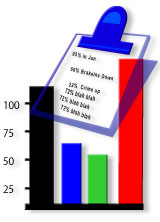|
Crime Analysis is defined as a set of systematic, analytical processes directed at providing timely and pertinent information relative to crime patterns and trend correlations to assist the operational and administrative personnel in planning the deployment of resources for the prevention and suppression of criminal activities, aiding the investigative process, and increasing apprehensions and the clearance of cases. Within this context, Crime Analysis supports a number of department functions including patrol deployment, special operations, and tactical units, investigations, planning and research, crime prevention, and administrative services (budgeting and program planning). – Steven Gottlieb et al., 1994, “Crime Analysis: From First Report to Final Arrest.”
The Irvine Police Department’s Crime Analysis Unit (CAU) currently tracks “preventable crimes” and crimes that lend themselves to series. “Preventable crimes” are those which are thought to be preventable or deterred by a marked police unit patrolling the city. The crimes and associated arrests tracked by the CAU are: Robbery, Burglary (Residential, Commercial, Vehicle), Thefts from Vehicles, Commercial Grand Thefts, Auto Theft, Auto Recoveries, Weapons and Narcotics Violations, Possession of Burglary Tools, Receiving Stolen Property, Sex Crimes, and Vandalism. The mission of the Irvine Police Department’s Crime Analysis Unit is to provide timely, accurate, informational support to line operations and investigators; to maintain an accurate crime and suspect database which facilitates quality analysis; and to produce and disseminate timely publications on crime series, patterns, trends, and offenders which will lead to the identification, arrest and successful prosecution of criminals. The CAU also provides administrative support in terms of producing staff reports, working on projects involving other city departments, and assisting in personnel scheduling. The IPD-CAU engages in three types of crime analysis: - Tactical crime analysis: An analytical process that provide information used to assist operations personnel (patrol and investigative officers) in identifying specific and immediate crime trends, patterns, series, sprees and hotspots, providing investigative leads, and clearing cases. Analysis includes associating criminal activity by method of the crime, time, date, location, suspect, vehicle, and other types of information.
- Strategic: Concerned with long-range problems and projections of long-term increases or decreases in crime (crime trends). Strategic analysis also includes the preparation of crime statistical summaries, resource acquisition, and allocation studies.
- Administrative: Focuses on provision of economic, geographic, or social information to administration.
In addition to acting as an internal resource for operations staff and administration, the CAU routinely fields telephone inquiries from the public requesting a variety of statistical information. The Unit works closely with Crime Prevention in the identification of hot spots and determines the best course of action to prevent additional incidences. The Crime Analysis Unit may be reached (949) 724-7121.
|

|